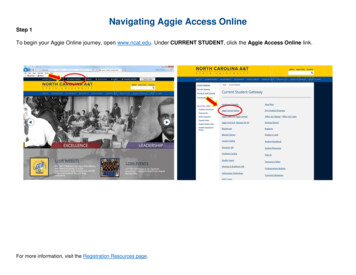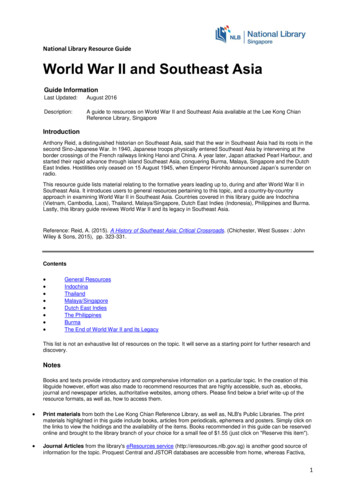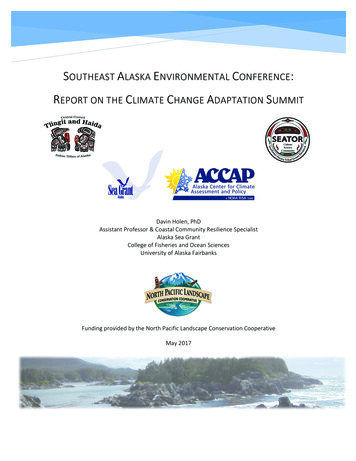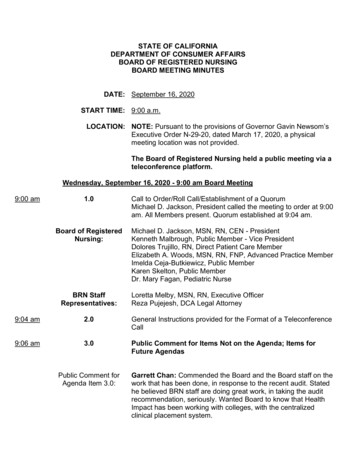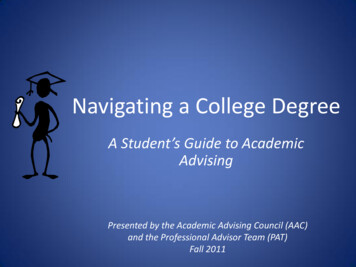
Transcription
Navigating a College DegreeA Student’s Guide to AcademicAdvisingPresented by the Academic Advising Council (AAC)and the Professional Advisor Team (PAT)Fall 2011
Part 1Degree Requirements
What is a Bachelor’s Degree? Completion of general graduation requirements–––––Minimum of 120 degree hoursNon-credit requirementsResidency requirementsMinimum 2.0 GPA at Southeast AND overallMinimum 39 hours upper division (300-599) courses Completion of University Studies requirements Completion of major requirements (courses and GPA) Completion of minor requirements, if required/selected
What is a Major/Minor? A major is a specialized area of study thatrequires a specific sequence of courses A minor is an additional area of study thatmay be required, optional or prohibiteddepending upon the major selected Major and minor information is available inthe University Bulletin
Declaring/Changing Your Major To change major or minor, students need toofficially declare the change in writing Policies may vary by department or college– Declare in academic department of major only OR– Declare in department or college advising center OR– Declare in college advising center only Consult your advisor before you decide tochange majors or minors
Double Major vs Double Degree A double major occurs when a studentdeclares more than one major A double degree occurs when a studentdeclares two majors that are part ofdiffering degree types– Biology (B.S) Psychology (B.S) double major– Marketing (B.S.B.A) Spanish (B.A) double degree– Advertising (B.S) History (B.A.) double degree This will add hours to your degreeprogram
Degree vs Non Degree Hours Undergraduate degree hours are coursesnumbered from 100-599 Developmental hours do not count in degreetotals, but do count when determining studentstatus Freshman 0 to 29 credit hoursSophomore 30-59 credit hoursJunior 60-89 credit hoursSenior 90 credit hours Developmental courses may be required basedupon ACT or other placement exam scores– Common non degree courses: MA050 and EN099
Passed Hours and Earned Hours
Non-credit Requirements Requirements which carry no credit hours– WP003 Writing Assessment Register via the MySoutheast Portal Must complete Written Expression (EN140) and 75 hours prior toenrolling Must pass BOTH writing samples Failing score will appear on transcript– Career Linkages proficiency checkpoints(CL001, CL002, CL003, CL004) Register via the MySoutheast PortalSequential requirements, to be completed over several semestersCL001 and UI100 must be completed concurrentlyFailing score in any will show on transcript
Non-credit Requirements cont. Measure of Academic Proficiency and Progress (MAPP)– MAPP1 Required for all incoming freshman and transfer/returning studentswith less than 60 hours Students register for MX001, then sign up for an individual testingdate/location on Testing Services’ website Failure to complete will result in a hold that prevents registration forthe upcoming semester– MAPP2 Must complete at least 90 hours prior to taking this assessment Register via Testing Services’ website Scoring at or above national average may waive graduation fee
Residency Requirements Minimum of 30 hours of thedegree must be completed fromSoutheast– Includes main, regional and onlinecampuses 12 of your final 18 hours of thedegree must be from Southeast– This allows for up to 6 hours oftransfer credit during your finalattendance periods
Academic Status To graduate, students must have at least:– 2.0 overall/cumulative GPA (C average)– 2.0 GPA for all courses taken at Southeast Some majors may require higher standards– Higher overall GPA and/or program GPA Failure to maintain a 2.0 GPA may affect:– Ability to take more than 12 hours a semester– Eligibility for financial aid– Eligibility for campus organizations and athleticsparticipation Low GPA could result in academic suspension
Southeast and Cumulative GPAs
What is a Catalog Year? Catalog year is the date used to determinegraduation requirements for a student– Normally assigned as the first semester of attendance– Transfer students should ask their advisors about theircatalog year because it could vary– Prevents students from being affected by mostchanges in program requirements that occur aftertheir first semester Students maintain their catalog year unless theirenrollment at Southeast is interrupted onecalendar year or longer
End of Part 1
Part 2University Studies Classes andOther Course Requirements
What is University Studies? University Studies is the name for Southeast’s generaleducation curriculum The goal of the curriculum is for students to fulfill nine specificlearning objectives The lower division requirements are equivalent to Missouri’s42 hour general education block requirements– 42 lower division hours (100-299) 9 upper division hours (300-599) 51 hours University Studies Many majors have courses that overlap University Studiesrequirements (i.e. MC101 would count for both Social Systemsand the Mass Communication major)
Did you earn college credit in high school? Make sure your advisor is aware of any college credit you mayhave completed or plan to take including:––––High school dual/early college creditAdvanced Placement (AP) creditMilitary creditTransfer credit from other colleges If you have credit from other colleges/schools, have officialtranscripts sent to Southeast For AP credit, request scores from the College Board be sent toSoutheast To verify what courses have been transferred, view yourunofficial transcript in the MySoutheast Portal or yourDegreeWorks degree audit
Do you plan to transfer credit from anotherinstitution? If you plan to take classes at another college, make sure they willcount towards your degree requirements You can check transferability for many colleges using the TransferCourse Conversion You can also ask the Registrar’s Officeto confirm how a course will transfer It is best to confirm transferabilityBEFORE you take the class
Where is the unofficial transcript?1.2.Click on the Students Tab in MySoutheast Portal.Enter My Southeast Self-Service within the portal – you have to click onthe Self-Service option on a second page also3.Click on Student, then Student Records, then Unofficial Transcript
What is a degree audit? DegreeWorks is a degree audit system that compares astudent’s individual credits to his/her selected program ofstudy and catalog year Your degree audit shows your degree progress– Shows the classes you’ve taken and which requirementsare met– Allows you to see which requirements are still needed– It also lists the classes you can take for each requirement The degree audit is the document used by the Office of theRegistrar when determining graduation eligibility An audit is a “snapshot” of credits at a particular point intime. Students should generate a new report after anyregistration changes– Some departments may also use program checksheets, butthese should only be used as a supplement to your audit
Where do I find my DegreeWorksdegree audit?In the MySoutheast Portal, under the Students tab, Bookmarks Plus column, clickon DegreeWorks student
Sample Degree Audit
End of Part 2
Part 3Advising and Enrollment
Who will help me? Each student is assigned an academic advisorbased upon major You can find your advisor’s name in theMySoutheast Portal, under Student Records,View Student Information To find contact information for your advisor,put your advisor’s name in “people search” onwww.semo.edu Students may be assigned to a new advisorwhen accepted into a selective program (suchas Nursing), changing campuses or changingmajors Some majors do group advising, but studentsstill have an assigned advisor
Why is advising required? Students are required to meet with theirassigned advisor each semester beforeenrolling The advisor will: provide guidance on course selection help students stay on track for graduation provide the alternate PIN studentsneed to enroll
Responsibilities for Advising Student Responsibilities Know the requirements for your chosen degree Know scholarship/financial aid requirements Work to establish both short- and long-term goals Seek help when needed and listen to your advisor’s advice Assume responsibility in making final decisions Advisor Responsibilities Help students clarify and set realistic goals Provide course suggestions Work with students to find solutions to problems Be considerate of a student’s unique needs and concerns
When should I make my advisingappointment? Before your priority registrationdate, when possible– Priority registration date isdetermined by earned hours (NOTin progress hours)– Priority registration dates arepublished in the portal Check with your advisor about preferred advising datesbecause these may vary by department Athletes, Governor’s Scholars and students registered withLearning Assistance Programs or Disability Services shouldmake appointments well before enrollment opens
Make the Most of YourAppointment Schedule before your priority registration date to avoidregistration delays Treat your advising appointment like a doctor’s appointmentor job interview– Call in advance if you need to cancel/reschedule– Arrive a few minutes early– Turn off your cell phone during the appointment Bring a list of potential courses for the next semester and anyother relevant materials – your degree audit will be useful forchoosing classes you need Write down questions in advance so you don’t forget to askthem during your appointment Mention any transfer credit, especially courses in progress orthose you plan to take
What is the Alternate PIN? Numeric password that permits students to use theMySoutheast Portal to add and drop classes Obtained from advisor during advising session Only valid for one semester– You get a new PIN from your advisor eachsemester Save your PIN until the end of that semester becauseyou may need it to add or drop classes later
How do I register?1.Enter My Southeast Self-Service within the portal – you have to click on the SelfService option on a second page also2. Click the Registration option3. Then click Add orDrop Classes
How do I register? (cont.)4. The next 2 screens will prompt you to choose the appropriate semester and enteryour alternate PIN5. Use Worksheet to enter CRN information directly OR click Class Search to look foravailable sections (The CRN is the 5-digit number to the left of the course prefixwhen looking up classes)Remember:Registration is open from 7am to9 pm daily
Why can’t I register? Registration may be prevented by:––––Attempting to register before Priority Registration DateUsing wrong alternate PINNot advised (no PIN)Attempting to register during a closed period(after 9 pm or before 7 am)– There is a hold that may be caused by: Owing a balance through Student Financial ServicesDid not attend First StepMissing permanent address (returned mail)Have not taken the MAPP1Other administrative hold (i.e. judicial, athletic)
How do I find out if I have a hold? Check the Registration Statusmenu in the My Self-Servicesection of the portal If you have holds, click onView Holds at the bottom ofthe page Holds are also listed on thetop of your degree audit If a hold is present, contactthe office and number listed If still uncertain, contactadvisor for assistanceBottom of page:
Registration Tips Make a tentative semester schedule prior to registering– View up-to-date availability the day before your Priority Registration Dateand make/revise your schedule as needed Look up CRN information in advance so you won’t spend as muchtime on the course search menu Click “Register” after each course to enroll in the class – entering theCRN in the worksheet does not enroll you until you click on “Register” Register at 7am on your priority registration date for the bestselection of courses Check course pre-requisites in the Undergraduate Bulletin– The portal may not prevent you from enrolling in a course even when you lack the prerequisites, but you could be dropped later by the department– Make sure you have the pre-requisites to avoid problems later Check the location when searching for courses to ensure you enroll atthe right campus
Why can’t I add this class? Read the error message All seats are taken (closed) “C closed” Department is restricting enrollment (controlled)– Contact department for more information on eligibility– May be a waiting list for additional openings Missing pre-requisites– Check course descriptions in the University Bulletin todetermine pre-requisites Missing co-requisites– Use ‘add to worksheet’ feature before submitting– Register for all connected elements of a course (i.e. CH005,CH085 and CH185 must be added together)
What if I need to take aclosed/controlled class? Contact the department that offers the course Add your name to a waiting list, if available– Waiting list formats vary by department If there is no waiting list, keep watching theportal for openings, especially:– When billing statements are mailed/due– Within the last few weeks before the first day of class
When You’re Ready to Graduate Register for your last semester as soon as possible,preferably on your priority date Once registered, generate a new DegreeWorksdegree audit to double check completion of allrequirements Apply for graduation by the deadline Respond in a timely manner to all mailings fromthe Registrar’s Office, including request for SeniorPapers Complete your final semester successfully Refer to Commencement website for semesterdeadlines and timelines
Online Advising ResourcesClick each link for more information: Online Registration How-To Handout (.pdf) DegreeWorks Audit/Worksheet How-To Handout (.pdf)Priority Registration DatesGPA CalculatorCommencementUndergraduate BulletinUniversity Studies Handbook
www.semo.edu Students may be assigned to a new advisor when accepted into a selective program (such as Nursing), changing campuses or changing majors Some majors do group advising, but students still have an assigned advisor

